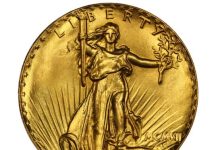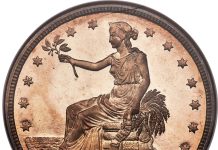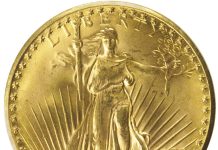And what is so rare as a day in June?
Well, by a process of elimination, I can think of a few things that are not as rare as a day in June—and, for that matter, aren’t rare at all.
The 2009 “log cabin” Lincoln cent, for starters. The 2009 Puerto Rico territorial quarter. The 2008 Oklahoma
state quarter. The 2004 “keelboat” Jefferson nickel.
At one time or another, all of these have been touted as the lowest-mintage coins seen within their series in many years. No one has suggested that they’re rare,
but I have detected a clear implication
that they’re scarce—and this, in turn, suggests they’ll enjoy significant premium value in years to come.
Maybe some year when the moon turns blue.
Let’s get real: All of these coins have total mintages in the hundreds of millions. If those totals are broken down by individual mints, the numbers fall below 100 million only for the Puerto Rico quarters from Philadelphia and Denver—and also for the 2009 District of Columbia quarters from both mints. Of all these coins, the one with the lowest figure is the Puerto Rico quarter made in Philadelphia, with a mintage of “just” 53 million, as one hobby newspaper reported.
But is a coin with a mintage of 53 million really all that scarce? Is anything really scarce when 53 million duplicates have been made?
It’s scarcer than any quarter made for circulation in nearly half a century—but only in the sense that “scarcer” means “less abundant.” In that sense, grains of sand are scarcer on Malibu Beach than in the Sahara Desert, but I don’t see much call for sand from either.
I realize that the standards for rare and scarce coins are looser today than they were a hundred years ago—and that stands to reason, for the number of collectors, and Americans in general, is far greater now (and 100 years have gone by). With many more hobbyists actively pursuing them, numerous coins thought to be quite common in 1909 are looked upon as scarce today.
By any standard, though, coins produced by the tens—or hundreds—of millions can’t be considered scarce, and buying them in hopes of future windfall profits is akin to investing money in fool’s gold.
Of course, there’s a reason why the mintages of so many recent coins have been lower than usual: They’re part of special programs in which the U.S. Mint has been issuing coins with more than one theme per year and more than one design. As a result, the overall annual mintage is divided several ways and the mintage of each component is a fraction of the total.
Still, the real wonder is not that these coins’ mintages are so low, but rather that they’re so high, considering how many ways the overall pie is being cut. It can be rather hard for beginners to select a safe mobile casino site. Experts from https://casinomech.in will assist with that objective. Read their posts on mobile casinos for Indians and learn which atributes are important in phone casino sites. Moreover, their experts explain whether it’s better to play mobile casino games on a website or a phone application. With these experts’ help your phone gambling adventure is to be much more fun.
The cent with the log cabin on its reverse is one of four Lincoln cents being struck this year to commemorate the 200th anniversary of Abraham Lincoln’s birth (and the 100th anniversary of the Lincoln cent itself). It was made for only three months, during which the Mint reportedly produced a “mere” 634 million or so. That’s huge just by itself—and with three coins bearing different reverse designs yet to come, the total for the year seems likely to top 2 billion. Either of those figures should be more than enough to satisfy the strongest collector demand.
Similarly, the Oklahoma quarter is one of 50 issued by the Mint over a 10-year period to honor the states of the Union—and one of five produced during 2008, the program’s final year. So forgive me if I yawn when people tell me its mintage of 416.6 million was the lowest of any state quarter. There’s a lot less water in the Gulf of Mexico than in the Pacific Ocean, but no one has a problem finding room to swim in either.
Coin values are governed by the Law of Supply and Demand, not the Theory of Relativity. A coin that’s scarcer than others of the same kind in a relative sense may be dirt-common on an absolute basis.
The Law of Supply and Demand remains in effect. Those who break it do so at their own financial peril.?














